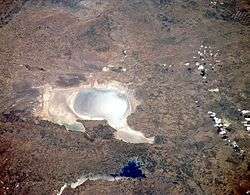Lake Tuz
| Lake Tuz | |
|---|---|
 View from space (April 1994) | |
| Location | Central Anatolia |
| Coordinates | 38°44′N 33°23′E / 38.733°N 33.383°ECoordinates: 38°44′N 33°23′E / 38.733°N 33.383°E |
| Type |
endorheic hypersaline |
| Primary inflows | Peçenek Çayı, Melendiz Çayı |
| Primary outflows | none |
| Catchment area | 11,900 km2 (4,600 sq mi) |
| Basin countries | Turkey |
| Max. length | 80 km (50 mi) |
| Max. width | 50 km (31 mi) |
| Surface area | 1,600 km2 (620 sq mi) |
| Average depth | 0.5 m (2 ft) |
| Max. depth | 1.5 m (5 ft) |
| Surface elevation | 905 m (2,969 ft) |
| Settlements | Şereflikoçhisar |
Lake Tuz (Turkish: Tuz Gölü meaning Salt Lake) is the second largest lake in Turkey with its 1,665 km2 (643 sq mi) surface area and one of the largest hypersaline lakes in the world.[1] It is located in the Central Anatolia Region, 105 km (65 mi) northeast of Konya, 150 km (93 mi) south-southeast of Ankara and 57 km (35 mi) northwest of Aksaray.
Geography

The lake, occupying a tectonic depression in the central plateau of Turkey, is fed by two major streams, groundwater, and surface water, but has no outlet. Brackish marshes have formed where channels and streams enter the lake. Arable fields surround the lake, except in the south and southwest where extensive seasonally flooded salt-steppe occurs.
For most of the year, it is very shallow (approx.0.4 m (1 ft)). During winter part of the salt is dissolved in the fresh water that is introduced to the lake by precipitation and surface runoff (to 32.9% salinity). During the summer the lake dries up exposing an average of 30 cm thick salt layer in August. This mechanism is used as a basis for the process of the salt mines in the lake. The three mines operating in the lake produce 63% of the salt consumed in Turkey. The salt mining generates industrial activity in the region, mainly related to salt processing and refining.
In 2001, Lake Tuz was declared a specially protected area, including all of the lake surface and surrounding waterbeds and some of the important neighboring steppe areas. The main Turkish breeding colony of greater flamingo (Phoenicopterus roseus) is present on a group of islands in the southern part of the lake. Greater white-fronted goose (Anser albifrons) is the second largest breeder here. Lesser kestrel (Falco naumanni) is a common breeder in surrounding villages.
Gallery
 Lake Tuz at sunset.
Lake Tuz at sunset. Lake Tuz
Lake Tuz In the dry season, the salt lake is transformed into a salt flat or playa.
In the dry season, the salt lake is transformed into a salt flat or playa.
See also
References
- ↑ Mustafa Yildiz, Ali Sinan Soganci (2010). "Evaluation of geotechnical properties of the salt layers on the Lake Tuz" (PDF). Academic Journals. pp. 2656–2663. ISSN 1992-2248.
External links
![]() Media related to Lake Tuz at Wikimedia Commons
Media related to Lake Tuz at Wikimedia Commons